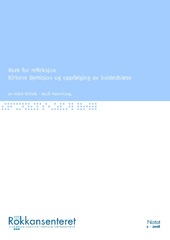| dc.contributor.author | Breivik, Jan-Kåre | eng |
| dc.contributor.author | Ravneberg, Bodil | eng |
| dc.date.accessioned | 2010-10-08T14:04:30Z | |
| dc.date.accessioned | 2020-12-10T06:31:19Z | |
| dc.date.available | 2010-10-08T14:04:30Z | |
| dc.date.available | 2020-12-10T06:31:19Z | |
| dc.date.issued | 2008-04 | eng |
| dc.identifier.issn | 1503-0946 | |
| dc.identifier.uri | https://hdl.handle.net/1956/4269 | |
| dc.description.abstract | During the last eight years the voluntary organisation Church City Mission in Oslo has established several housing facilities and housing arrangements in combination with follow-up services for homeless people in Oslo city. The Church City Mission offers today permanent housing facilities and dwellings for women, temporary dwellings for drug addicts, educational courses, activity centres and follow-up services as well as ambulant services to homeless people. The overall aim for the organisation is to develop houses and dwellings in combination with follow-up services in order to improve people’s standards of living and their life situation. This is a study of four specific houses and the organisation’s follow-up services to homeless women and men in Oslo on behalf of public services. This work started in 2001 as a result from the national project to combat homelessness, «Project Homelessness». This project was continued as a national strategy called «The pathway to a permanent house» in the period between 2005 and 2007. The four houses that have been studied are Nåløyet/Natthjemmet, Steenstrupsgate 11, Thaulows vei and Schandorffsgate. These houses and follow-up services meet an accumulated need in the municipality of Oslo and represent an important variety when it comes to housing and dwellings for homeless people in the city. An important topic in this study is how the organisation’s emphasis on follow-up services as being time consuming and relational work is challenged by public services that expect results quickly. The first part of the study focuses on the development of the organisation of the follow up services. The study shows that it has not been an easy task to organise and coordinate the services and that the organisation is working on how to anchor the services better within the organisation. The study also shows that the four services cooperate differently with social services in the municipality, something that add to the complexity and conditions the work differently. The other part of the study focuses on different aspects of the follow-up position and the user’s meanings about, and experiences with how it is to live in the houses. We discuss the different challenges and methodologically implications for the positions such as being a «coach» or an «advocate». The last chapter discusses different issues regarding how the services both professionally and methodologically can be developed further in the future. | en_US |
| dc.description.abstract | I løpet av de siste åtte årene har Kirkens Bymisjon i Oslo etablert flere bo- og oppfølgingstilbud som permanente boligtilbud til kvinner, kortidstilbud for rusavhengige, pedagogisk boligskoletilbud, aktivitetshus med boliger, oppfølgingstjenester samt ambulerende tjenester. Kirkens Bymisjon sitt overordnede mål med det boligsosiale arbeidet er å utvikle boliger med tilbud om oppfølging der dette kan bidra til å bedre bo- og livssituasjonen til den enkelte. Denne undersøkelsen dreier seg om fire slike bo- og oppfølgingstilbud i regi av Kirkens Bymisjon i Oslo. Dette er tiltak som ble igangsatt i kjølvannet av det nasjonale «Prosjekt Bostedsløse» som startet i 2001 og som ble videreført gjennom den nasjonale strategien «På vei til egen bolig» fra 2005 til 2007. De fire tilbudene som er nærmere omtalt i undersøkelsen er Nåløyet/Natthjemmet, Steenstrupsgate 11, Thaulows vei og Schandorffsgate. Disse bo- og oppfølgingstilbudene fyller et oppdemmet behov for booppfølgingstjenester i Oslo kommune og representerer et viktig mangfold på tilbudssiden. Et gjennomgående tema i undersøkelsen er hvordan Bymisjonen sin vektlegging av booppfølgertjenesten som tidkrevende relasjonsarbeid støter på utfordringer, særlig i forhold til det offentliges forventninger om raske resultater. Den første delen av undersøkelsen omhandler trekk ved utviklingen av oppfølgingstjenesten siden tilbudet startet opp. Undersøkelsen viser at det ikke har vært lett å organisere og koordinere oppfølgingstjenesten og at det arbeides med å forankre tjenesten bedre i organisasjonen. Undersøkelsen viser også at tilbudene inngår i ulike samarbeidskonstellasjoner med sosialtjenester i ulike bydeler, noe som legger ulike premisser for arbeidet. Den andre delen av undersøkelsen tar for seg ulike sider ved selve booppfølgerrollen og brukernes egne synspunkter og opplevelser av botilbudet. Her drøftes ulike utfordringer i forhold til både den tette «coach-rollen» og den mer utadrettede «advokat-rollen», spennvidden mellom disse rollene og de metodikker som knytter seg til dem. Til slutt drøftes hvordan tjenesten kan utvikles videre faglig og metodisk. | no |
| dc.language.iso | nob | eng |
| dc.publisher | Stein Rokkan Centre for Social Studies | eng |
| dc.relation.ispartofseries | 2-2008 | en |
| dc.relation.ispartofseries | Notat | no |
| dc.title | Rom for refleksjon. Kirkens bymisjon og oppfølging av bostedsløse | nob |
| dc.type | Working paper | eng |
| dc.rights.holder | Stein Rokkan Centre for Social Studies | eng |
| dc.subject.nsi | VDP::Samfunnsvitenskap: 200 | nob |
